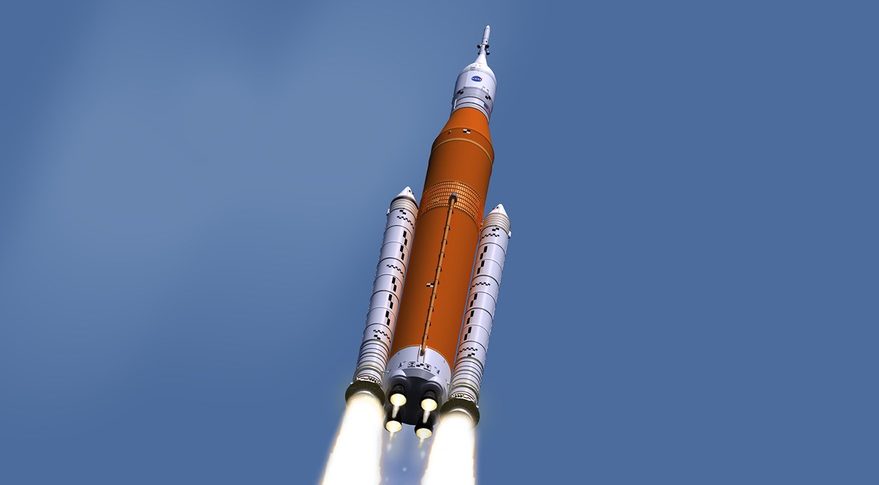Boeing Plans Changes for Upper Stages NASA's Space Launch System Megarocket
BREMEN, Germany — With NASA's decision to continue using an interim upper stage for additional flights of the Space Launch System, Boeing is working on changesto both that stage and a more powerful upper stage.
In an Oct. 3 call with reporters, John Shannon, vice president and program manager for the Space Launch System at Boeing, said NASA has asked Boeing to look at changes to the Exploration Upper Stage (EUS) to improve its performance.
Those changes were prompted by the decision NASA made earlier this year to delay the introduction of the EUS. That stage was originally planned to enter use with the second SLS mission, Exploration Mission (EM) 2. Instead, the first flight of what's known as the Block 1B configuration of SLS has been delayed to the fourth SLS launch, likely no earlier than 2024. [Photos: NASA's Space Launch System for Deep Space Flights]
"That has put a slow down on the Exploration Upper Stage work," he said. "We were rapidly approaching the critical design review."

"We're actively working through additional design opportunities to lighten the stage and increase its performance and take even more out to the lunar area, so that the Gateway can be built and we can get human boots back on the surface of the moon," he said.
Shannon said later neither the company nor NASA had a specific goal for increasing the EUS' performance. "It's a very open-ended discussion with NASA," he said, describing it as an opportunity created by the delay in the stage's introduction. "We have some really sharp guys. They're going off and coming up with some really great options for NASA to consider." Those options include changes to the stage itself as well as orbital mechanics techniques.
While he said there was no specific goal for that performance increase, he mentioned later in the call "all the work we're going to do to try and get one or two extra tons of co-manifest payload." NASA has previously advertised a co-manifested payload capacity of about ten tons for the SLS Block 1B.
Get the Space.com Newsletter
Breaking space news, the latest updates on rocket launches, skywatching events and more!
The decision to delay the EUS' introduction means flying two additional SLS Block 1 missions with the original Interim Cryogenic Propulsion Stage (ICPS). One of those missions will be for EM-2, the first crewed Orion flight, while the other is being reserved for the launch of NASA's Europa Clipper spacecraft to Jupiter's moon Europa.
Shannon said NASA is handling procurement of the additional two ICPS units from United Launch Alliance, which based it on the Delta 4 upper stage. That should be completed in the "next couple months," he said.
The ICPS was originally not planned to be human-rated, but will undergo some changes to be used on the EM-2 mission. The biggest change is the addition of an emergency detection system similar to one used on the Centaur upper stage of the Atlas 5 on commercial crew missions. Additional sensors and instrumentation will be added to the stage both for redundancy and to give astronauts on Orion more information about the status of the stage.
During the call Shannon also addressed the schedule for development of the SLS. The core stage, for which Boeing is the prime contractor, has been on the critical path for the EM-1 launch in mid-2020. It has been running "neck-and-neck" with the Orion service module, as Mark Kirasich, NASA Orion program manager, described it a briefing earlier that day.
"That's a good characterization of it," Shannon said. The focus is getting the core stage completed and delivered to the Stennis Space Center in Mississippi "at the beginning of next summer." It will spend about six months there undergoing testing, including a full-duration firing of its four RS-25 engines.
Once those tests are complete, the core stage will go to the Kennedy Space Center to be integrated with its solid rocket boosters, ICPS and Orion spacecraft for an additional six months of testing. "It looks like everything is lining up and we're staying in sync with Orion from a schedule standpoint," he said. "We'll be able to support the needs of the program."
He admitted that the program had underestimated the amount of effort that would go into developing the vehicle, which has suffered several years of delays. "We underestimated that somewhat. We thought we would be able to reuse hardware without as extensive a [qualification] as we've done on some it," he said. "But as we got into testing and understood the environments in an SLS, it required us to go back and do additional qualification work."
This story was provided by SpaceNews, dedicated to covering all aspects of the space industry.
Join our Space Forums to keep talking space on the latest missions, night sky and more! And if you have a news tip, correction or comment, let us know at: community@space.com.

Jeff Foust is a Senior Staff Writer at SpaceNews, a space industry news magazine and website, where he writes about space policy, commercial spaceflight and other aerospace industry topics. Jeff has a Ph.D. in planetary sciences from the Massachusetts Institute of Technology and earned a bachelor's degree in geophysics and planetary science from the California Institute of Technology. You can see Jeff's latest projects by following him on Twitter.










